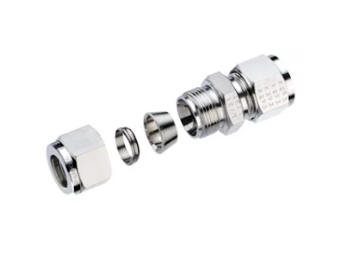Technical Blog
Medium Pressure Tube Fittings used in stainless steel tubing; 3 types

There are three primary styles of medium pressure tube fittings. They are differentiated by their end connections, each having its own advantages and disadvantages in specific applications.
⇒ Compression Fittings: Slide over the tube and use a ferrule design to coin and seal on the OD of the tube.
⇒ Butt Weld Fittings: Permanently joins to the tube end by welding the surrounding metal at the tube end with the fitting.
⇒ Cone and Thread Fittings (C&T): Tube ends are coned (chamfered) and threaded. The threads allow for positive lock and sealing the end face of tube to the fitting body.
They can all be used with medium pressure to high pressure tubing. Seamless stainless steel tubing provides a much more reliable performance than the use of longitudinally welded tubing.
For medium pressure applications (up to 15,000 psi) stainless tube fittings are specified by the tubing OD (outside diameter); i.e. 1/4, 3/8, 1/2, 3/4 inch (6, 10, 12, 20 mm). Each style of fitting is available with the specified size end connections and in different configurations, such as: ⇒ Straight ⇒ Elbow ⇒ Tee ⇒ Cross Sometimes they are used as reducing fittings; for instance from a larger size connection such as 3/8 to a smaller, 1/4 tube. Many are also available with the designated style (i.e. compression) on one port to an alternative connection on another port, such as NPT or SAE thread, or male NPT to C&T and many other combinations.
Cone and Thread Fittings
Cone and Thread (C&T) connections are sometimes used in very high pressure applications (up to 150,000 psi), but are most frequently used for “medium pressures” of up to 15,000 psi. They provide a solid and tight connection, where the tube is chamfered (“coned”) and countersunk into the fitting. To ensure a tight seal, the tube ends must be precision formed with a fine surface finish and then threaded so the tubing is assembled firmly against the joint. All of this is typically performed in the field, significantly increasing the installation time and overall cost of using of C&T fittings. However, like compression fittings, C&T fittings can be broken down and re-assembled for maintenance.
These processes are not always repeatable or consistent. They can also introduce metal shavings and cutting oil into the tubing ID, creating the requirement for an additional cleaning operation. Special training is required to use the tools necessary for C&T fittings. And because the joints are threaded in uncontrolled environments, the fittings can become loose when subject to vibration.
Butt Weld Fittings
Though C&T fittings still provide a very solid connection when installed properly, some studies have found that for every three corrosion failures in the field, there is at least one vibration failure. The assembly that provides the best protection against vibration is a butt weld fitting. Since the metals are being permanently joined together, a well formed butt weld has the best resistance to vibration and fatigue. However, a butt weld fitting connection still has some disadvantages, including cost. The cost of welding equipment, a specialized welder and the extra labor time can make a butt weld connection the most expensive of the three types of fitting assemblies.
In addition, field maintenance of fluid systems can be difficult, if not impossible, with butt weld fittings due to the potential inaccessibility of the joint and/or the maintenance crew not having the tools or skills available to cut and re-weld a connection.
Compression Fittings
The most common and easiest to install are compression fittings. This design uses a friction grip on the tube. Compression fittings are made up of three components: nut, body and ferrule (single or double). The ferrule coins (compresses) the tube and provides a tight grip on the tube surface. Compression fittings have superior vibration resistance over C&T fittings, but not over Butt Weld. This style of fitting does not require any special equipment or tools. Simply slide the tubing into the end connection, and tighten to the required torque with a box wrench (or torque wrench for precision applications). Because of their ease of installation, the use of compression fittings is usually the least expensive overall assembly.
Compression fittings also perform well with thinner walled tubing, which allows for higher flow rates and can be more easily bent and handled. Thinner walled stainless steel tubing used with compression fittings can allow up to 33% more flow through the tubing than the comparable size C&T. Thinner wall seamless tubing can bend with only 70% of the force required to bend a similar tube used with C&T fittings. This allows for more flexibility in the application, particularly in field assembly where tube bending equipment is not assessable. However thinner walled tubing may not be able to withstand higher pressures, even in the “medium pressure” range.
Conclusion
With any mechanical fitting connection, there is the potential for leaks whether from improper assembly, vibration or other long term failure. In many cases, mechanical fittings are the best solution. Yet, whenever possible, using a continuous length of seamless coiled tubing is likely the best method for transferring gas or liquids. In some applications, such as the transfer of high pressure gas underground, mechanical fittings are not permitted by fire codes. This is becoming a more frequent application in the growing CNG (compressed natural gas) industry, where vehicle refueling stations are being installed around the world. In these applications, many hundreds of feet of coiled seamless stainless steel tubing may be installed underground. There are many other above ground or indoor applications which also require the transfer of media over long distances, making long length coiled tubing the preferred and least expensive method. However, thinner walled tubing may not be able to withstand higher pressures, even in the “medium pressure” range.
Sources: Parker HannifinSwagelok
Reference: HandyTube







